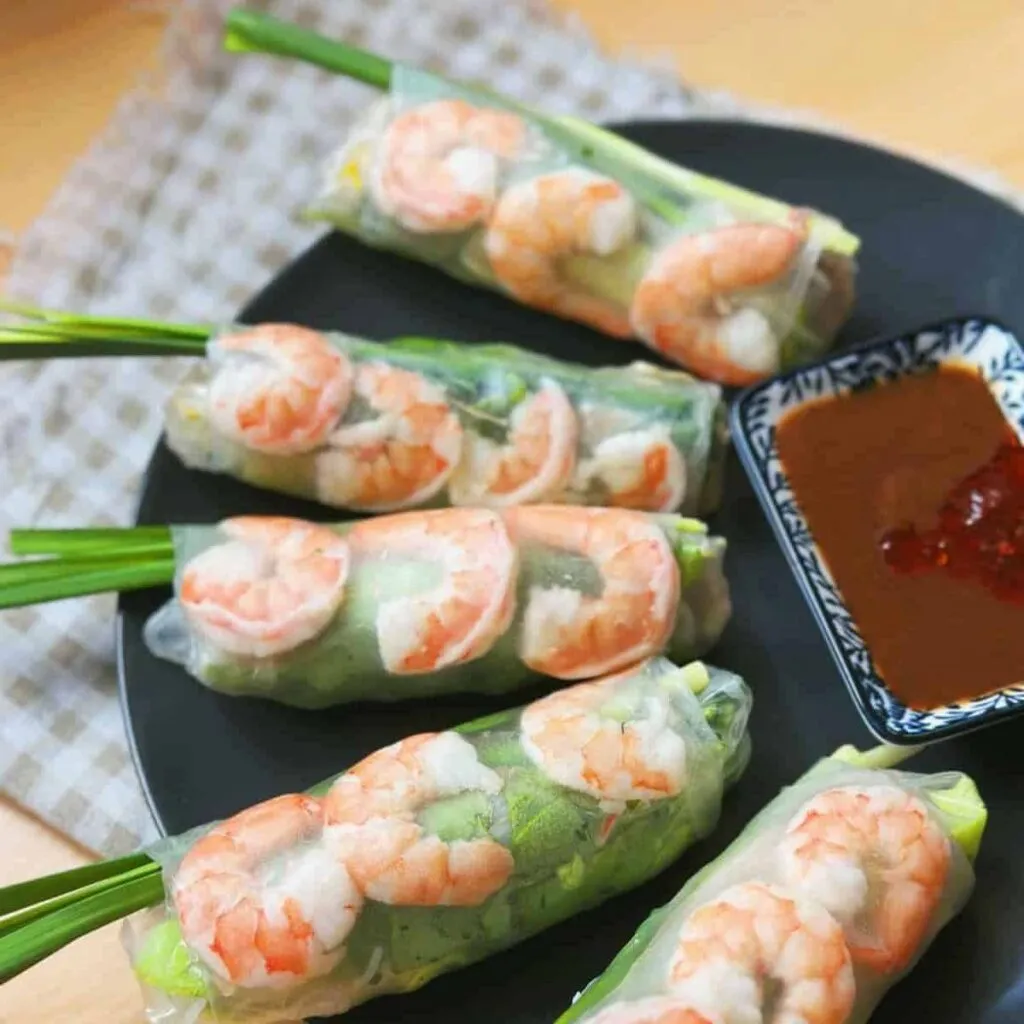Canh Chua (or Canh Chua Cá) is my go-to refreshing and comforting soup during the scorching summer in Vietnam.
Cooking it in Germany is quite tough because it requires several exotic ingredients that I have to hunt down in different Asian markets, and they’re rarely available at the same time.

So, whenever I’m back in my home country, I enjoy this soup as much as I can. Today, I’m excited to share the recipe for Canh Chua, the signature soup from the Mekong Delta in Vietnam.
Table of Contents
What is Canh Chua?
Canh Chua , in Vietnamese, literally means to “Sour Soup,” though its taste profile is a harmonious blend of sweet, sour, savory and spicy.

This quarter of flavors is a hallmark of Southeast Asian cuisine, much like the well-loved Thai Tom Yum and Filipino Sinigang.
In Vietnam, from north to south, you’ll find countless variations of Canh Chua, each showcasing the diverse ways Vietnamese locals infuse sourness into the soup.
From well-known ingredients with tamarind, calamansi, and fermented mustard greens to more exotic renditions with:
- Dracontomelon fruits (quả sấu)
- Sour-soup creeper leaves (lá giang)
- Pickled bamboo shoots (măng chua)
- Sour fermented rice (cơm mẻ)
- Rice wine vinegar (giấm bỗng)
In Germany, I sometimes use rhubarb stalks to cook Canh Chua.
The Canh Chua recipe I’m sharing today is the most sought-after rendition beyond Vietnam. Rooted in the flavors of the Mekong Delta (Miền Tây), it has become a beloved staple throughout Southern Vietnam as well as the entire country.
When in Saigon, you can find this soup at almost every Cơm Bình Dân food vendor.
Cơm Bình Dân, meaning “Commoner’s Rice,” offers family-style meals at affordable prices for blue-collar workers.
If you’re visiting Saigon and want to experience the local daily life, I recommend trying Cơm Bình Dân at least once. Some of my recommended side dishes are:
What is in Canh Chua?
You can find the ingredients at Asian markets. For precise measurements, refer to the recipe card at the end of this post.
Vegetables & Herbs
Cooking Canh Chua requires several exotic vegetable ingredients, which might be a bit overwhelming if you’re new to Vietnamese cuisine (lol, Vietnamese herbs and vegetables can be tricky).
In Vietnam, it is quite convenient because we can buy prepacked ingredients at supermarkets or have the greengrocers at local wet markets gather each ingredient according to the quantity we need.

Today, I picked up a package of Canh Chua ingredients from the nearby supermarket. Let’s open it up and see what’s inside.

- Tomato and pineapple: They add sweetness and a slight sourness to the soup. You can use fresh or canned pineapple along with its juice (just adjust the sugar accordingly).
- Tamarind: This is the key ingredient that gives the soup its distinct sour flavor. My mom often uses fresh tamarind (straight from the pod), while I prefer tamarind pulp (the thick and sticky paste) or concentrate for convenience. Tamarind powder works well too.
- Choose the products from Southeast Asian brands. I once tried Indian tamarind in Germany, and it tasted quite different.

- Beansprouts: Beansprouts are a must-have ingredient in Canh Chua.
- Shredded banana blossoms: optional but popular in my hometown’s version. In Vietnam, we often use banana blossoms to make banana blossom salad or incorporate them into noodle soups like:
- Okra (đậu bắp): a popular addition to Canh Chua. Okra has a mild taste and a distinct slimy texture. It doesn’t impart much flavor but adds texture to the soup.
- Elephant Ears/Taro Stems (bạc hà/dọc mùng): These have a unique texture, like a sponge that absorbs the soup’s flavor. Sometimes I use celery stalks—not quite the same, but still quite nice.
Seasonings & Garnish
- Sugar, Fish Sauce & Chicken Powder: These help to balance the flavor of the tamarind.
- Herbs: I highly recommend at least using rice paddy herbs. For the last resort, you can substitute with Thai basil or lemon basil.
- Rice Paddy Herbs (ngò om, rau om, rau ngổ): Essential for an authentic Canh Chua, these herbs have a light citrus lemon taste with earthy cumin undertones.
- Culantro/Sawtooth Herbs (ngò gai): A common companion to rice paddy herbs in Mekong Delta’s Canh Chua.
- Lemon Basil (é trắng): Popular in central Vietnam (like in my hometown).
- Green Onions (hành lá): Optional.


- Thai chilies: Optional. They add a spicy kick.
- Fried garlic (tỏi phi): A popular garnish to Canh Chua in the Mekong Delta. I highly recommend fried garlic if you have it on hand, as it elevates Canh Chua to another level. Some people prefer fried shallots (hành phi).
- Fried garlic and garlic-infused oil are also great in making Vietnamese mayo.
Protein
- In the Mekong Delta area (Miền Tây), locals often opt for freshwater fish such as:
- catfish (cá basa, cá bông lau, cá hú)
- snakehead fish (cá lóc)
- red tilapia (cá diêu hồng)
- In Nha Trang, my hometown, a coastal city, we also use seawater fish like mackerel and tuna.
- Just use any kind of fish like salmon, halibut, cod, or even shrimp and squid to cook Canh Chua.
- If you can get fish heads, use them to cook. They impart a lot of umami flavors.
- If you don’t like seafood, you can make Canh Chua with pork ribs, bone-in chicken, or tofu (vegetarian Canh Chua).
You could use fish fillets or have the fishmonger cut the whole fish into 1-inch (2cm) thick steaks with the backbone and skin still intact.
Rub and rinse the fish, especially the catfish, with coarse salt to remove the slime coat. If you want to reduce the fishy odor, rub the fish with some minced ginger.
Instructions
Prepare the ingredients
- Fry the minced garlic in cooking oil until it turns golden brown (be careful as it’s easy to burn).
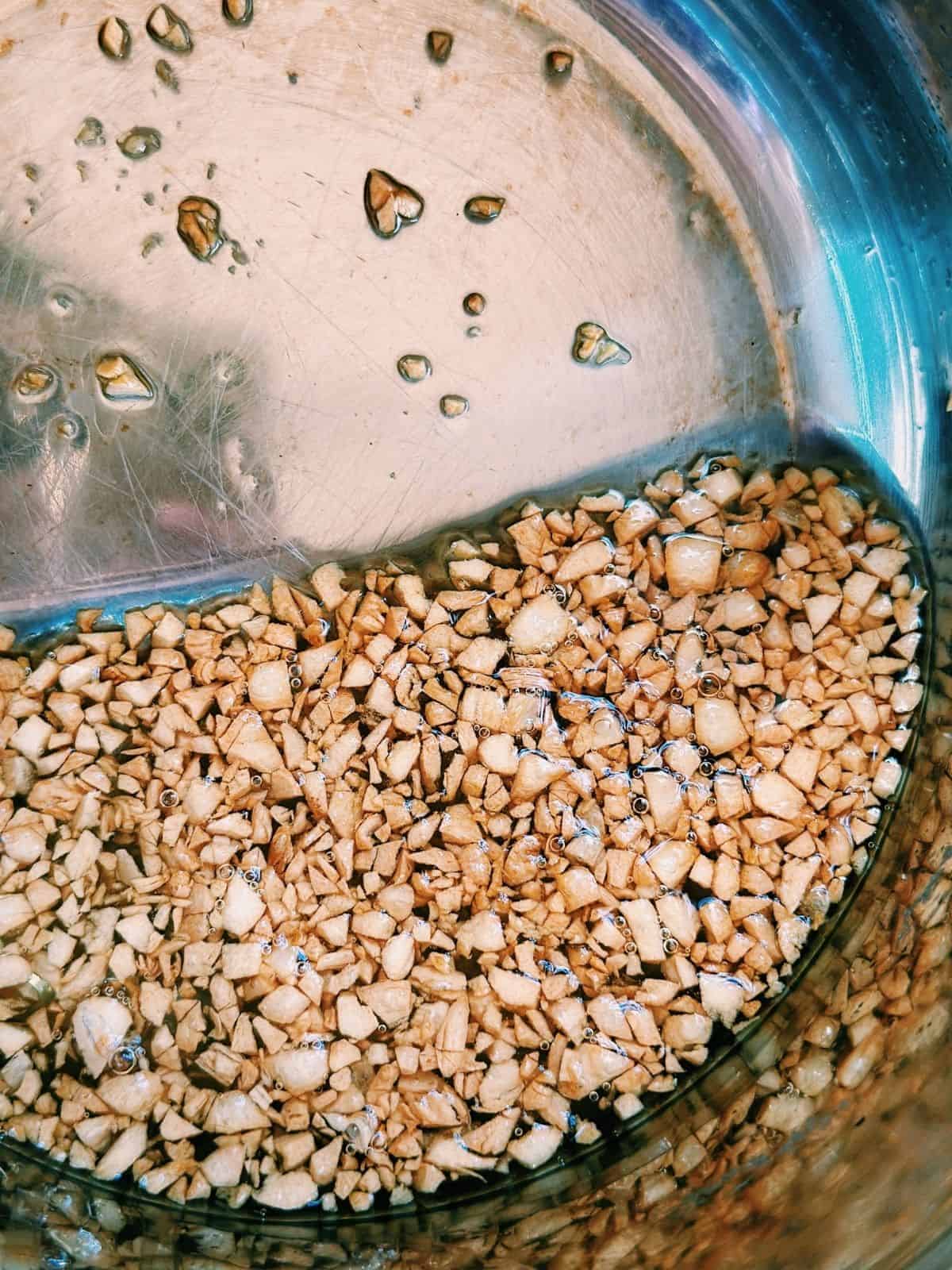
- Finely chop the herbs and slice the chili.
- Trim the stem ends of the okra and cut it into 1/4 inch (0.5 cm) pieces.
- Peel the elephant ear stems and cut them diagonally into 1/2 inch (1 cm) pieces.
- Cut the tomato into thick wedges and the pineapple into bite-sized chunks. If using canned pineapple, drain and reserve the liquid, then cut the pineapple rings into bite-sized pieces.
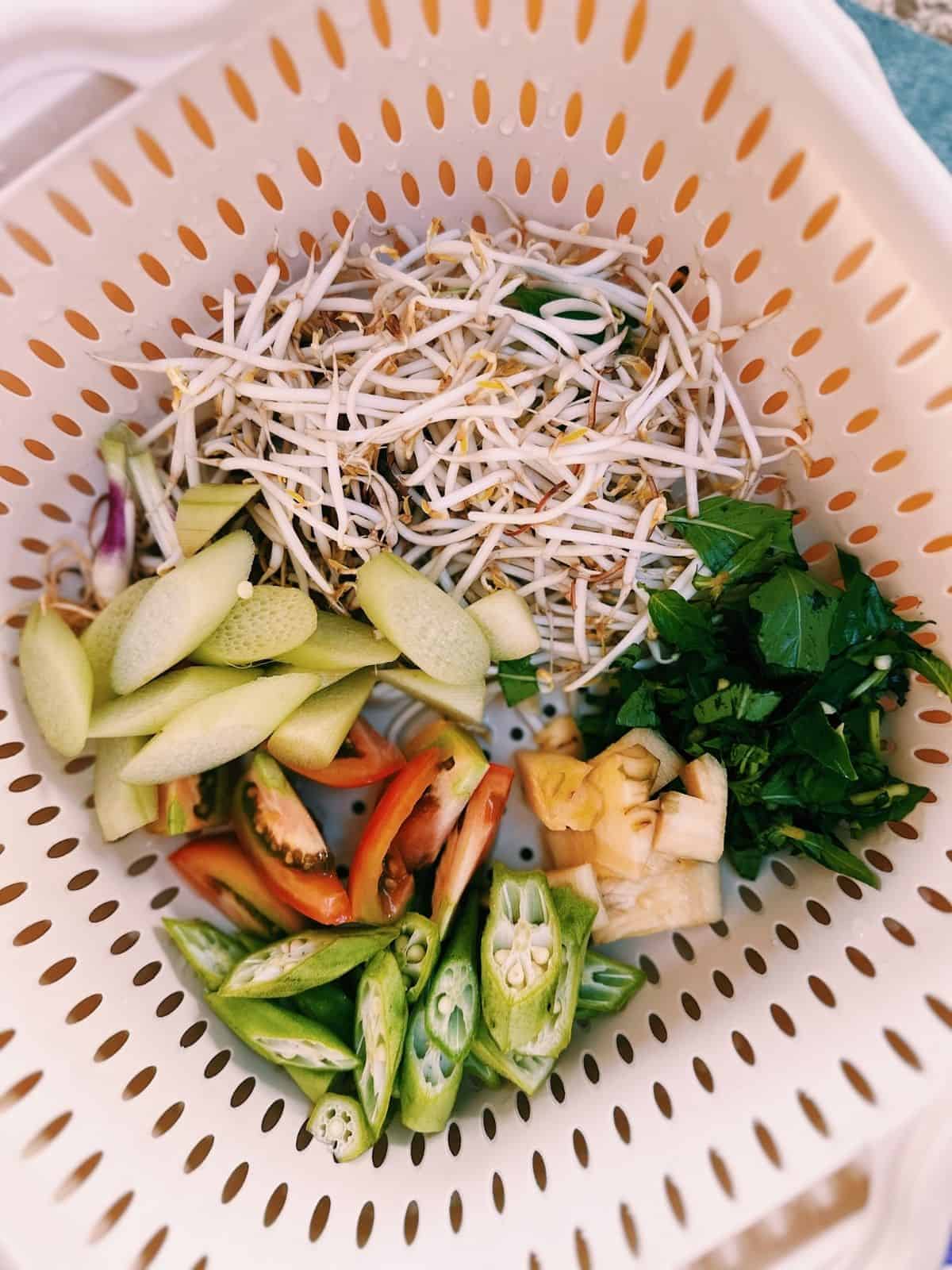
Cook the soup
- In the pot, add boiling water. Add the tomatoes and pineapple (reserve 2-3 wedges of tomato for decoration). Simmer over medium-low heat to release the fresh flavors.
- In a heatproof bowl, place the tamarind pulp. Add 2 ladles of boiling water from the pot. Use a spoon to crush the tamarind pulp and dilute it into the water to make a concentrate. Skip this step if using store-bought tamarind concentrate or powder.
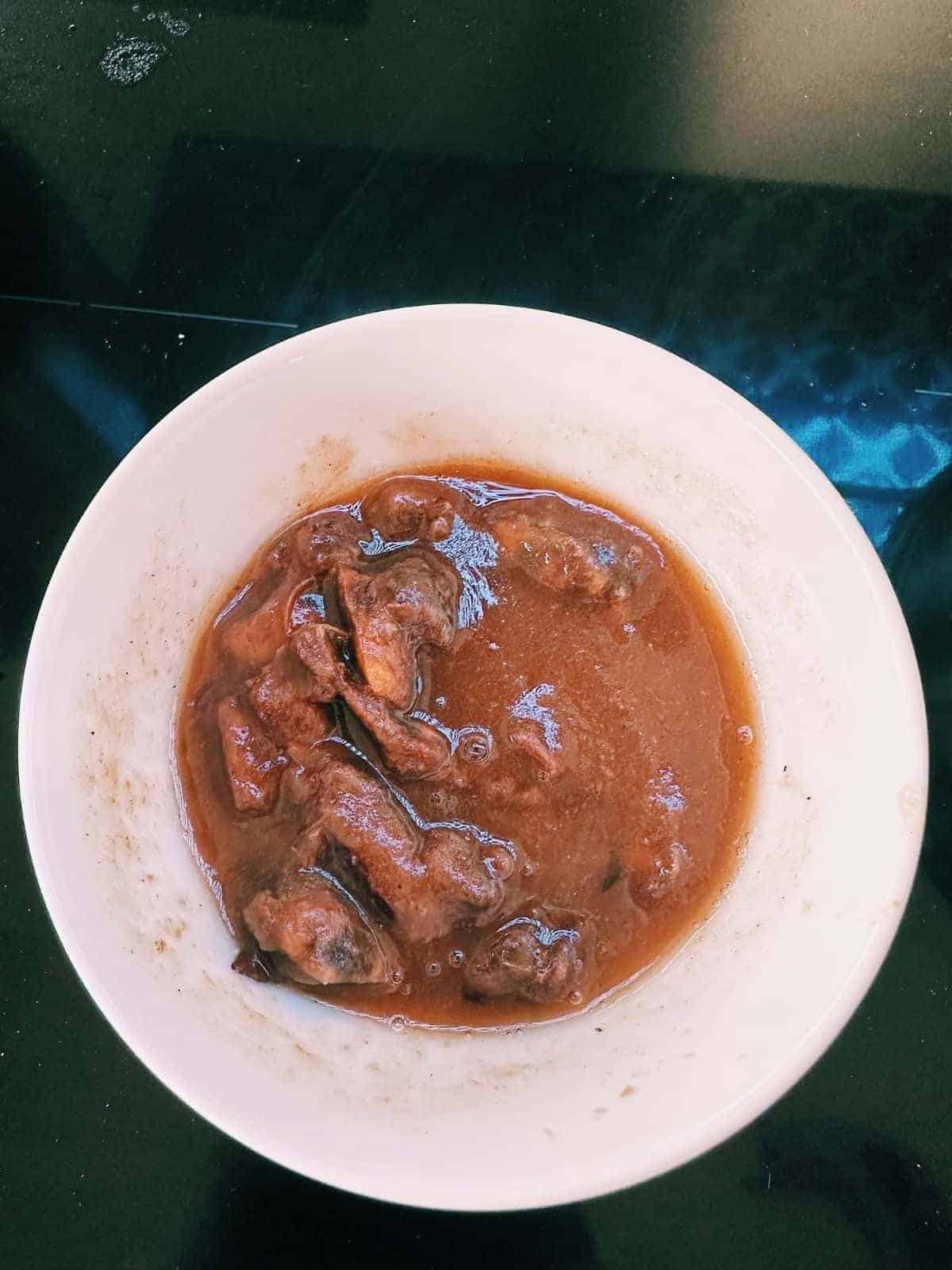
- Return 3-4 tbsp the tamarind concentrate (without seeds) to the pot. Season the soup with fish sauce, chicken powder, sugar, and the juice from the pineapple can (if using). Adjust each ingredient gradually, avoiding adding them all at once. The flavor of Canh Chua is slightly sweeter and less sour than Thai Tom Yum.
- Bring the water to a boil again. Add the fish and cook on medium-high heat for around 5 minutes or until the fish is cooked through.
- Add the okra, elephant ear stems, and reserved tomato. Cook for another 1 minute.
- Turn off the heat. Add the bean sprouts, shredded banana blossoms (if using), and chopped herbs (setting aside a bit for garnish). Give it a stir (Don’t cook the bean sprouts and herbs for too long). Season a final time with fish sauce and sugar.
- Serve the soup in a large bowl and garnish with the reserved herbs, sliced chili, and fried garlic.


Serving
A traditional family meal in the Mekong Delta typically has a bowl of Canh Chua and a plate of Cá Kho Tộ (caramelized fish in a clay pot), served with steamed jasmine rice.
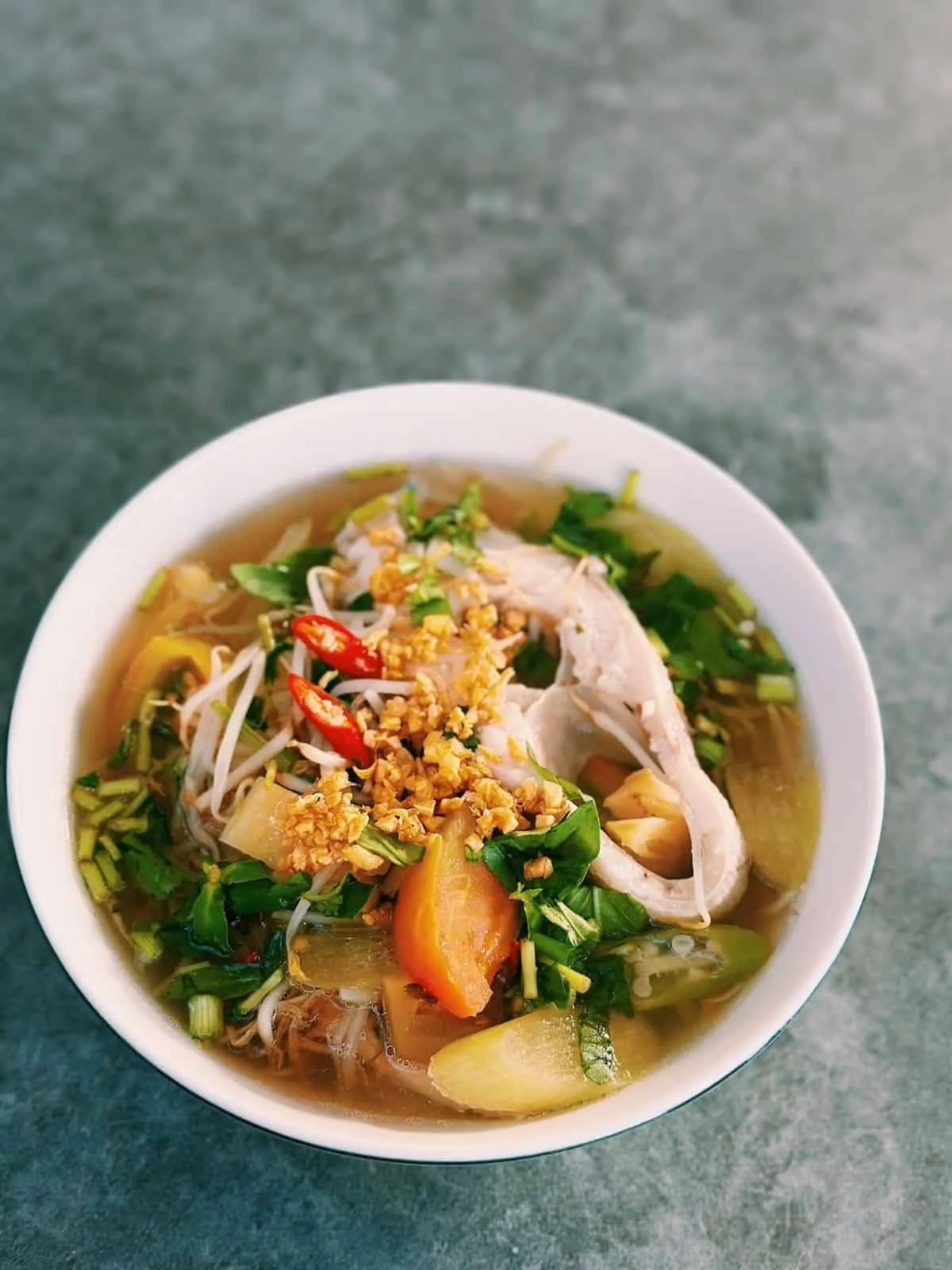
Normally locals often use the fish head and tail to cook Canh Chua, reserving the steak for Cá Kho Tộ.
Local people often take the fish out of the soup and dip it in a side dish of fish sauce with some sliced chili (pure fish sauce, without sugar or vinegar, unlike Nước Chấm dipping sauce).
You can also spoon the soup and vegetables over steamed rice and enjoy.
FAQs
Authentic Vietnamese recipes that everyone can cook





Vietnamese Sweet & Sour Soup (Canh Chua Cá)
Ingredients
- 1 pound fish (catfish, salmon, mackerel, tilapia) (fish heads, fillet or steak with bone and skin attached)
- 1 cup pineapple chunks (fresh or canned) (about 1/4 a small pineapple)
- 2 tomatoes (cut into thick wedges)
- 2 oz tamarind paste (55g) (to your taste) (or tamarind concentrate/powder)
- 3 cup beansprouts
- 1 cup shedded banana blossoms (optional)
- 2 elephant ear stalks (peeled, cut diagonally into 1/2-inch or 1 cm pieces)
- 5 okras (optional) (the stem ends trimmed, cut into 1/4-inch or 0.5 cm pieces)
- 1.5 tbsp sugar (to your taste)
- 2 tbsp fish sauce (to your taste)
- ½ tbsp chicken powder (to your taste)
- 5 cup boiling water (1.2 liter)
- Thai chilies (thinly sliced)
- 1 handful rice paddy herbs (ngò om/rau ngổ) (finely chopped) (highly recommend)
- 1 handful sawtooth coriander, lemon basil, Thai basil (finely chopped) (substituted for paddy herbs)
- 1 tbsp fried garlic (or fried shallots) (optional)
Instructions
- In a pot, pour in boiling water. Add the tomatoes and pineapple (reserving 2-3 wedges of tomato for garnish). Simmer over medium-low heat to allow the fresh flavors to infuse.
- In a heatproof bowl, place the tamarind pulp. Add 2 ladles of boiling water from the pot. Use a spoon to crush the tamarind pulp and dilute it into the water to make a concentrate. Skip this step if using store-bought tamarind concentrate or powder.
- Add 3-4 tbsp of the tamarind liquid back (without seeds) to the pot. Season the soup with fish sauce, chicken powder, sugar, and the juice from the pineapple can (if using). Adjust each ingredient gradually, avoiding adding them all at once. Canh Chua has a flavor profile that is slightly sweeter and less sour than Thai Tom Yum.
- Bring the water back to a boil. Then, add the fish and cook over medium-high heat for about 5 minutes or until the fish is fully cooked.
- Next, add the okra, elephant ear stems, and the reserved tomato. Cook for an additional minute.
- Turn off the heat. Stir in the bean sprouts, shredded banana blossoms (if using), and chopped herbs (reserving some for garnish). Be cautious not to overcook the bean sprouts and herbs. Season the soup once more with fish sauce and sugar if needed.
- Serve the soup in a large bowl, garnishing it with the reserved herbs, sliced chili, and fried garlic.

